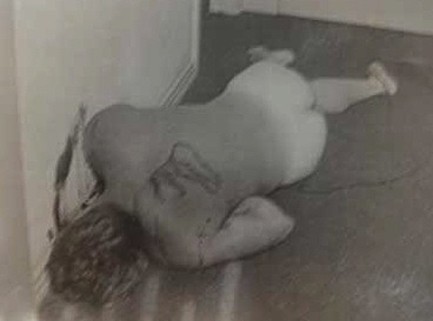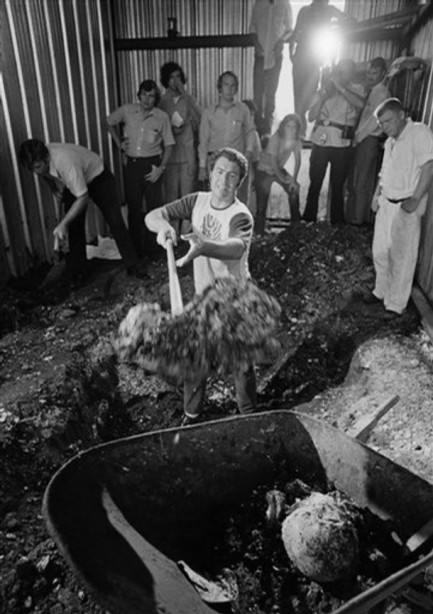 Fitzgerald and friends enter the no-go zone. 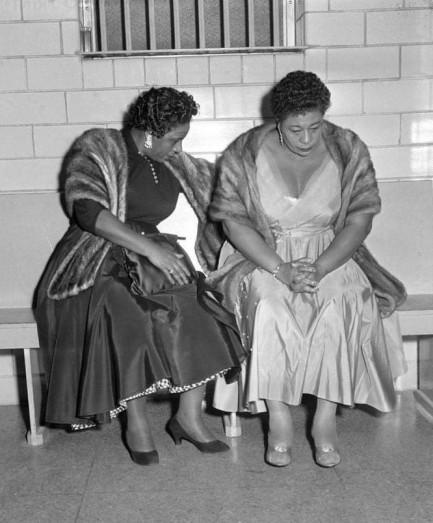
Today in 1955 in Houston, musicians Ella Fitzgerald, Dizzy Gillespie, Illinois Jacquet, personal assistant Georgiana Henry, and concert promoter Norman Granz were arrested, ostensibly for the crime of illegal gambling. Five undercover cops had barged into the backstage area at the Houston Music Hall during a mid-set break and caught Jacquet and Gillespie playing craps. Fitzgerald was having a snack. Henry was nearby, as assistants tend to be. And Granz was arrested for blocking the cops' access to Fitzgerald's private bathroom because he feared they might plant drugs—a trick he'd seen before. The photo shows Fitzgerald and Henry. The despondent singer told gathered reporters, “I have nothing to say. What is there to say? I was only having a piece of pie and a cup of coffee.”
The gambling charge was, of course, just a pretext. Ella and company were actually arrested for playing to an integrated audience. Segregation had been made illegal the year before, but local authorities weren't budging in their attempts to keep the city divided, and jazz music, because of its popularity and tendency to elevate black culture, was feared by the old guard as the thin edge of the wedge of equal rights. Back then, opponents of equality called non-segregated shows such as Fitzgerald's “forced integration,” because whites had no option to partake without mingling with blacks. The phrase is eerily similar to “forced diversity,” which you hear a lot in 2022, and will continue to hear in upcoming years.
Pretext arrests are really about plausible deniability. Even today on fact-checking websites like Snopes, the arrest is not fully labeled an incident of racist harassment. They were actually gambling, goes the logic. But so were thousands of other Houstonians that night, including, probably, cops at poker sessions in their dens. Everyone breaks the law. Policing is about who is targeted. Five of Houston's finest bursting into a private backstage area when no probable cause existed is itself proof that the arrest was harassment. But it's the cops who write the record, and in covering up their true motivations they also get to skew official history. It's the oldest game in the book.
Fitzgerald and her companions weren't taken to jail until after they completed the few songs left in their show, a concession doubtless bestowed in order to prevent the audience from getting riotous. After being released the musicians made it back to Houston Music Hall and played a second contracted show—again, leniency that was probably a crowd control measure, if not a favor to the concert venue itself. The police had accomplished their objective. They'd sent a message and, because news media were present at the jail, had embarrassed the performers nationally. We suspect that Fitzgerald's heart wasn't really in that second performance. It had to be clear to her that no matter what protections blacks were given with a pen and ink in Washington, D.C., actual power in the south flowed from a corrupt badge and the muzzle of a gun.
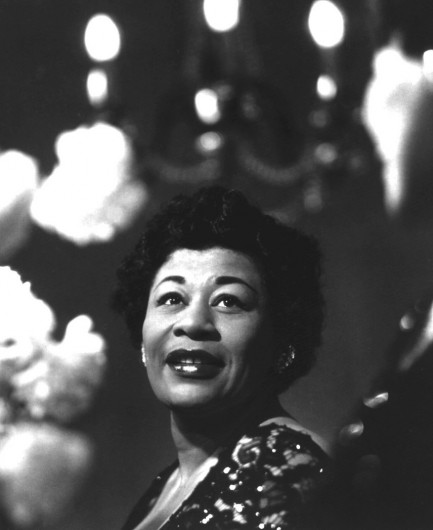 If you want to hear Ella at her magical best, have a listen to this.
 It's about time you got here Clarence Joe—I'm like to die of desperation. 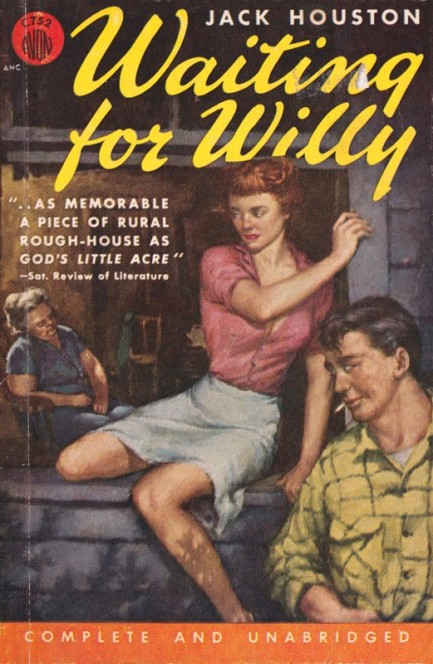
We can't tell you for sure, since Jack Houston's 1952 novel Waiting for Willy dates from well before were born, but we suspect “willy” was a slang term for penis even back then. We think so only because we keep finding what we thought were contemporary slang terms in these old books. We wish we'd thought before now to make a list. You'd be surprised. Apart from some hip-hop expressions—and even including many of those—the slang already existed and was used in the same context. Of course, authors often borrowed terminology from early- and mid-century African American vernacular, which makes the whole process circular, sort of. We'll wait for a comprehensive study on the subject from you linguists out there, and as the cover shows, anticipation is the best part. The art on this is by George Erickson, who you can see more of by clicking his keywords below.
 A Rampage of epic proportions. 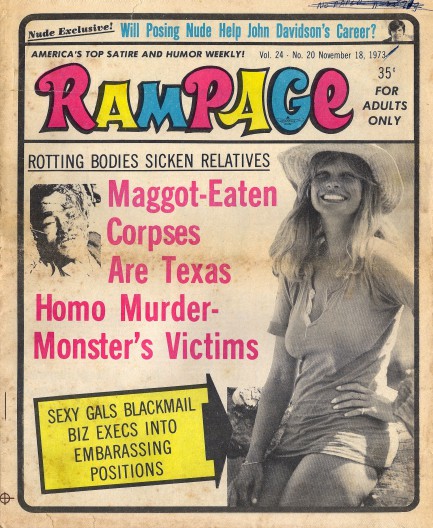 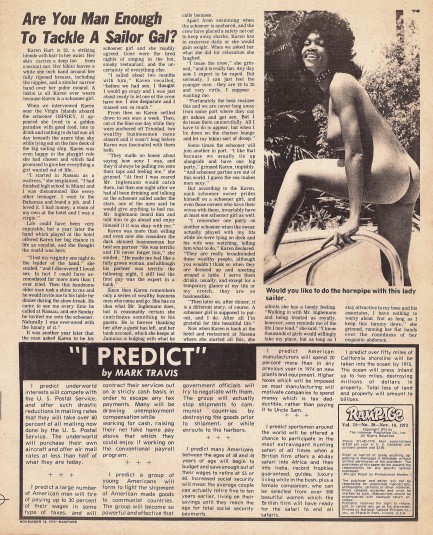 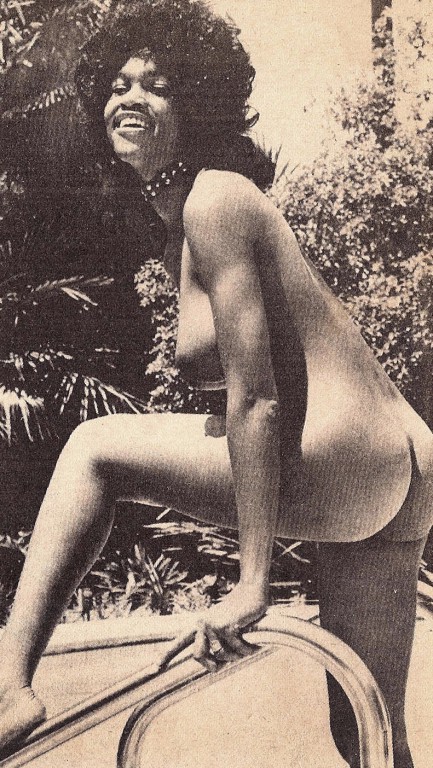 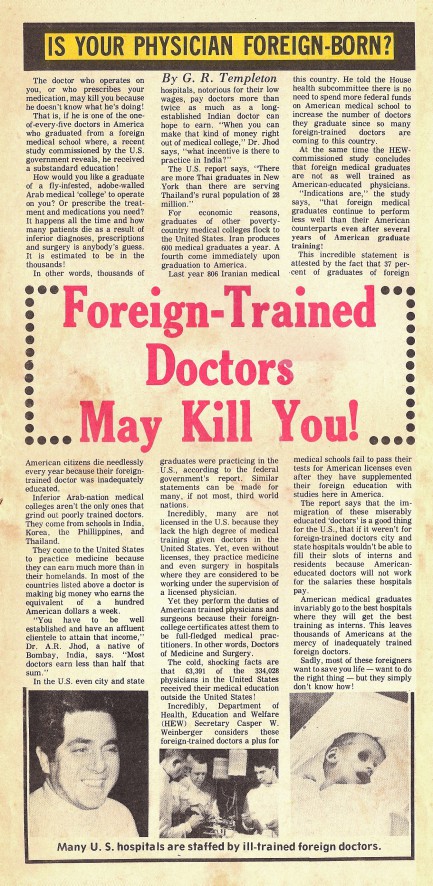 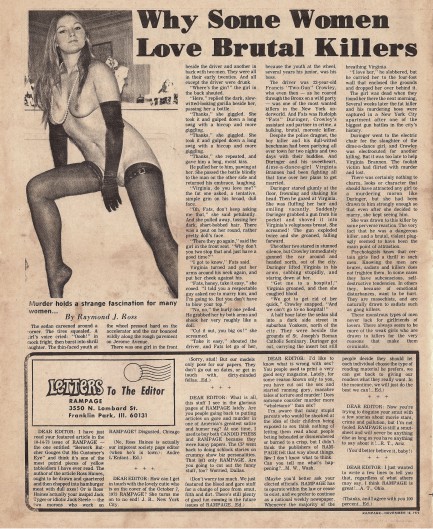 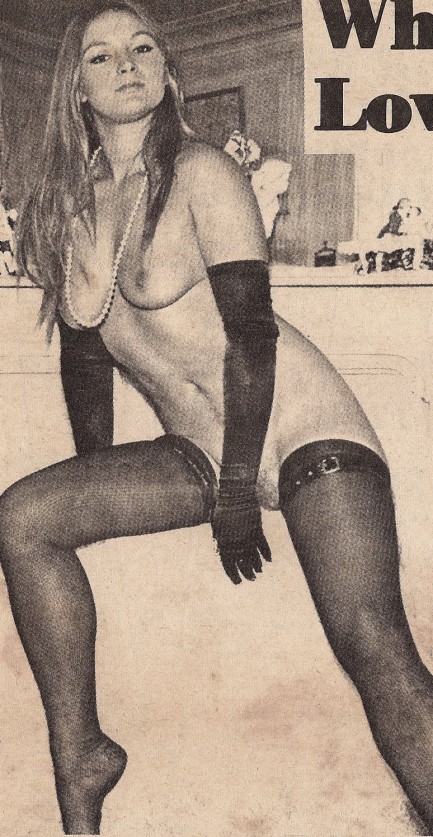 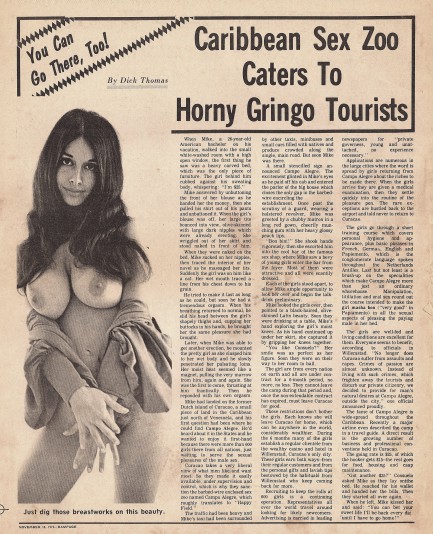 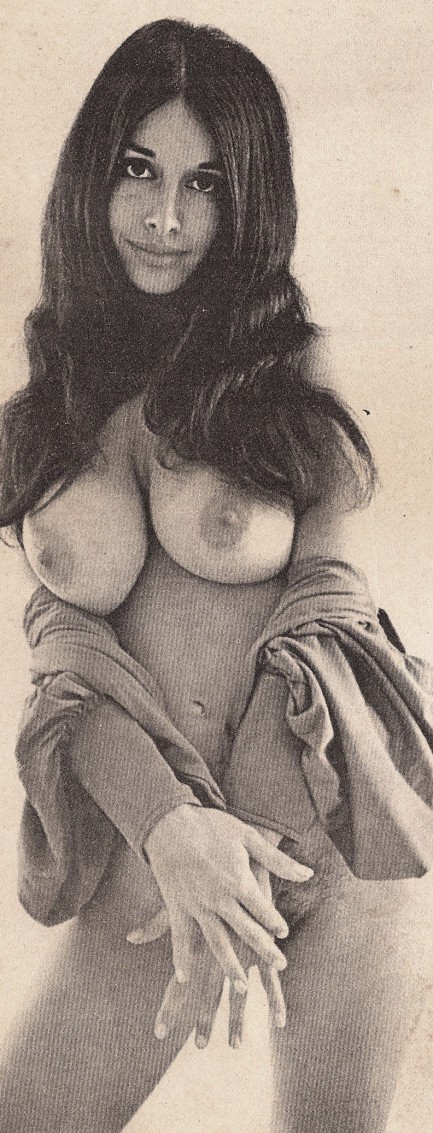 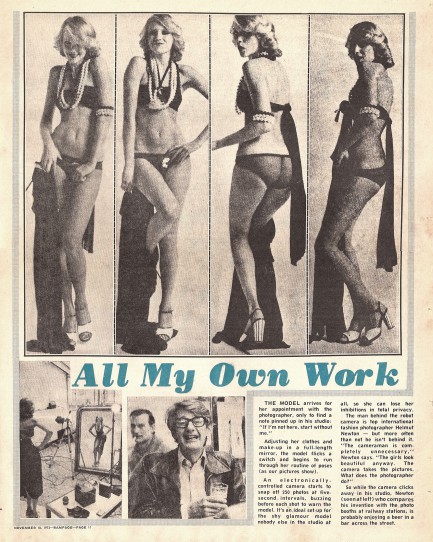 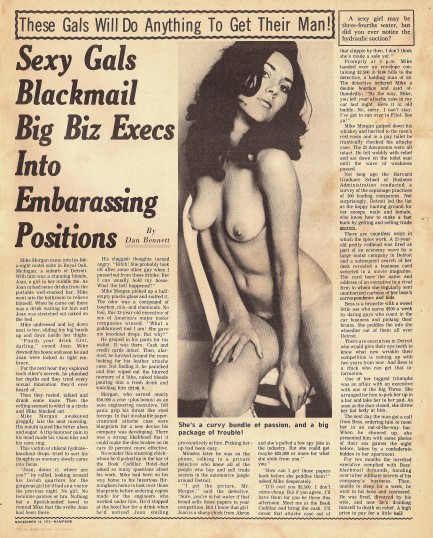 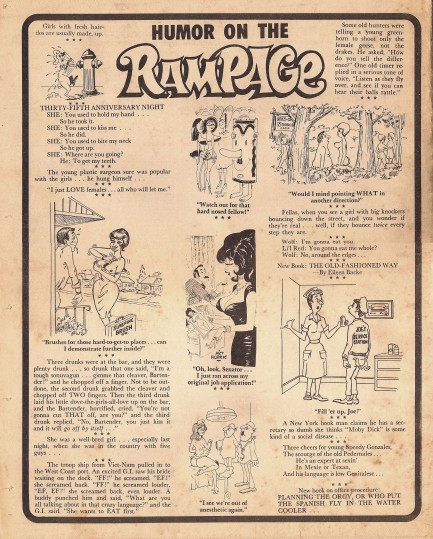 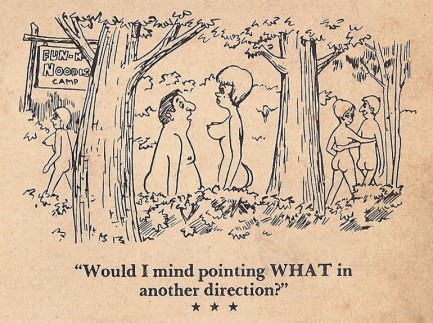
Lots of skin this week. Don’t blame us. It’s all a matter of publishing randomness. You know we like to share items on the date they originally appeared, and it seems the stars have aligned for a naked mid-November. Above you have a Rampage published today in 1973, with rare photos of German actress Alice Arno and men’s mag fave Joyce Gibson. The monster referenced on the cover is Dean Corll, a serial killer who abducted, raped, tortured, and murdered at least 28 boys in and around Houston, Texas, from 1970 to 1973. He had been killed two months earlier by his accomplice Elmer Wayne Henley during a showdown over two potential victims, and terrifying details of the crimes had been laid bare for the American public, which was still trying to wrap its head around the concept of serial killers. We may get into the Corll murders a bit later. This is our eighth issue of Rampage, and you can see the others at our trusty tabloid index.
 You wouldn’t mind terribly if we steal your nickname? 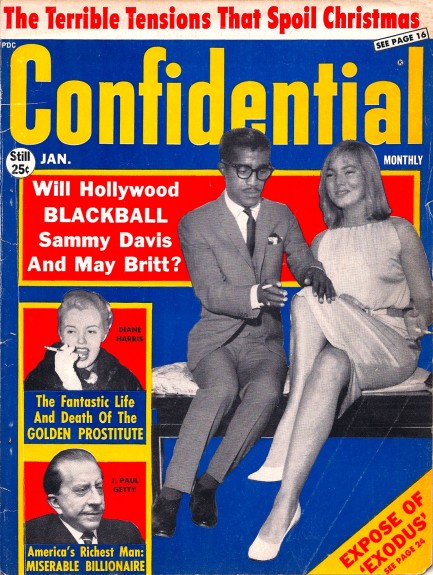 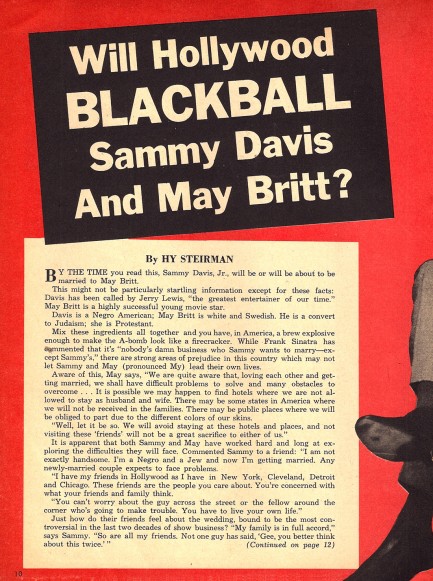 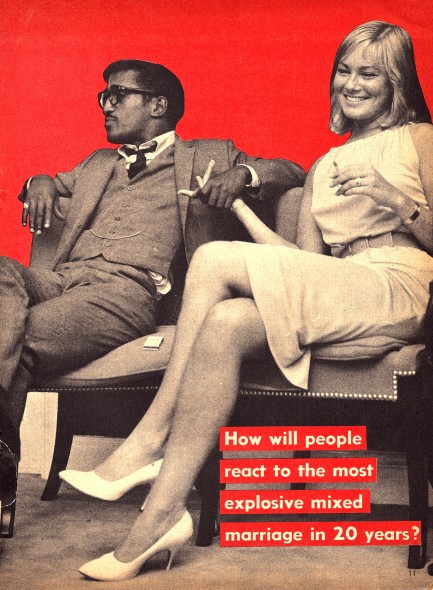
Today we have a January 1961 issue of Confidential for you, with cover stars Sammy Davis, Jr. and May Britt. Since we’ve already discussed Sammy and May of late, and even made her a recent femme fatale, we’ll skip past them and focus on another interesting story—the tale of Diane Harris, who shot to notoriety as a witness in the infamous Minot Jelke pimping trial of 1952. We wrote about it back in 2009—Jelke was an oleomargarine heir who was cut off from his trust fund and decided to turn his girlfriend Patricia Ward into a prostitute in order to make ends meet. Ward became known as the “Golden Girl of Vice” and “The Golden Girl of Café Society,” which is why it’s interesting that Confidential calls Diane Harris “The Golden Prostitute.” Apparently Jelke had the Midas touch. Confidential wastes no time in its article. It begins: She gave herself a title… Lady Diana Harrington. The New York D.A. gave her another… the Golden Girl of Café Society. Houston police gave her a third, less flamboyant title… prostitute. Uh oh—the New York District Attorney’s nickname for Harris is identical to Patricia Ward’s nickname. After a few more paragraphs of reading, it becomes clear that Confidential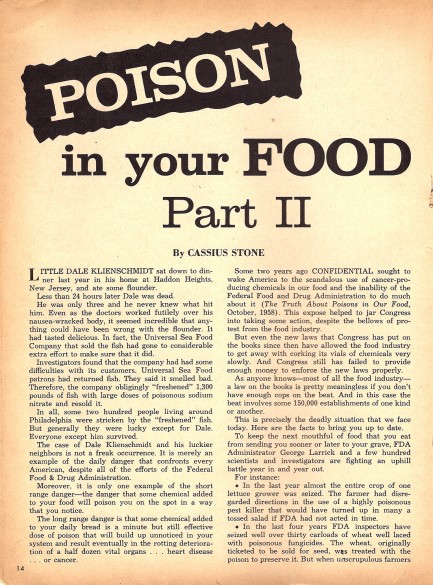 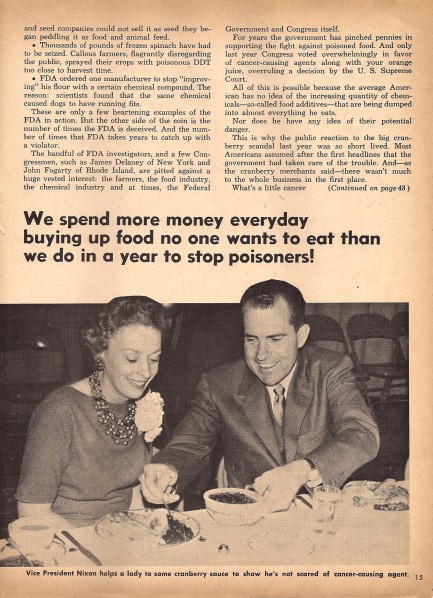 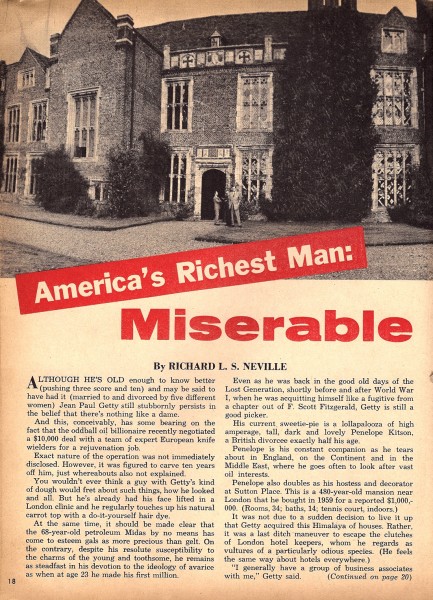 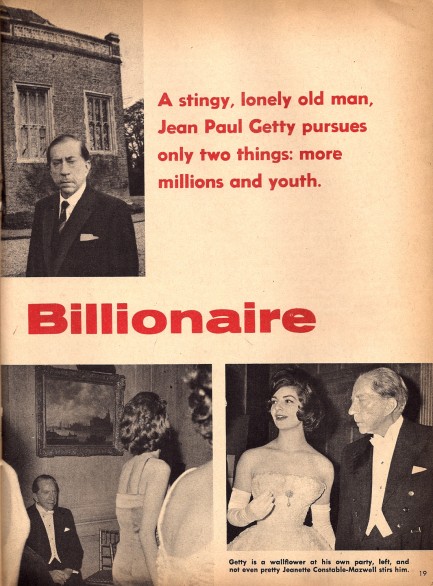 believes the Golden Girl is Diane Harris—not Patricia Ward. While it’s true that Harris did use some aliases, including Lady Diana Harrington and Mary Lou Brew, nowhere is the name Ward mentioned as a pseudonym. believes the Golden Girl is Diane Harris—not Patricia Ward. While it’s true that Harris did use some aliases, including Lady Diana Harrington and Mary Lou Brew, nowhere is the name Ward mentioned as a pseudonym. After searching high and low for some idea of whether we were dealing with one woman or two, we finally saw in the IMDB page on the 1995 Jelke biopic Café Society that Patricia Ward and Diana Harris were played by separate actresses—Lara Flynn Boyle and Cynthia Watrous. So was there some confusion in 1961 about who exactly the Golden Girl was? Looking back at our original post on the subject, the photo of the Golden Girl on the cover of Hush-Hush shows a blonde. Confidential has numerous photos of their Golden Girl Diane Harris, and a single photo they identify as Pat Ward. Just plain Pat—no Golden, no nickname at all. And she’s a brunette. So not only does Confidential identify the Golden Girl of Café Society as Diane Harris—turns out so did that March 1961 Hush-Hush. We just didn’t realize it at the time. Our mistake came when we first researched the Jelke trial and found a New York Times movie review that identified Pat Ward as the Golden Girl. From that point we just ran with it and never thought to doublecheck. Until today. Now, based on available evidence, it seems that at some point over the intervening years the historical record got twisted and the label Golden Girl was applied to Patricia Ward, where it stayed even up to the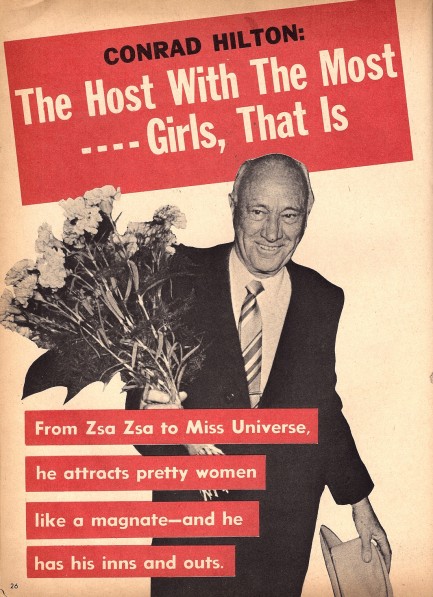 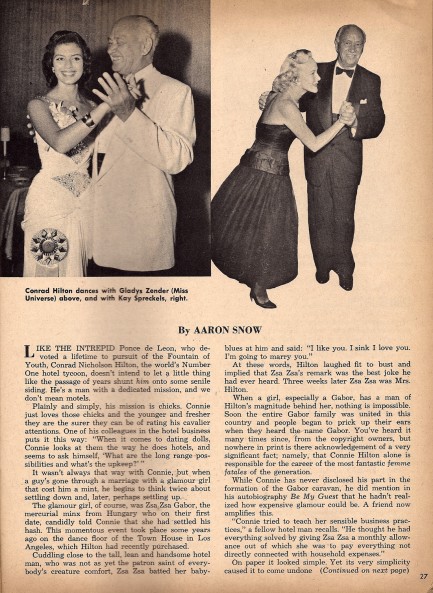 point of a Hollywood motion picture misidentifying her. She was indeed Minot Jelke’s girlfriend, whereas Harris was just a fellow high dollar prostie (and corroborating witness), so perhaps some clever scribe, or even the writers of the 1995 movie, decided that such a catchy nickname would be better applied to the girlfriend. At least that’s the way it looks to us. point of a Hollywood motion picture misidentifying her. She was indeed Minot Jelke’s girlfriend, whereas Harris was just a fellow high dollar prostie (and corroborating witness), so perhaps some clever scribe, or even the writers of the 1995 movie, decided that such a catchy nickname would be better applied to the girlfriend. At least that’s the way it looks to us. If we’re right, is any of this important? Does it matter that Harris was fleeced of her nickname, or possibly that a movie took liberties and those liberties were later assumed to be facts? Do we expect an award? No, not really, but it’s interesting. Confidential barely recounts the events of the trial. The story is actually about Diane Harris being found dead in a Houston apartment eight years afterward, in September 1960. She was still a prostitute at the time. Confidential tells us: The blonde’s nude body was in bed, a green sheet and a pink blanket covered her. Pictures of her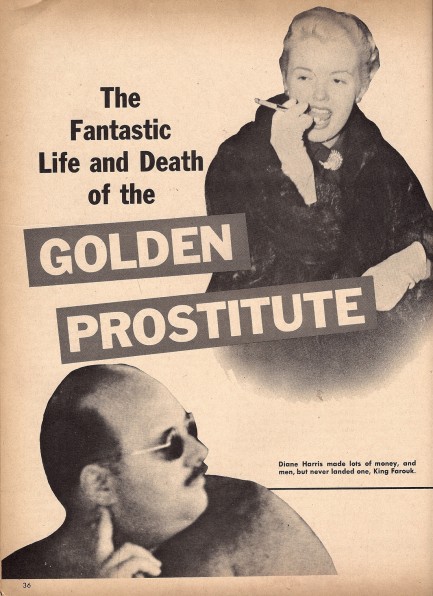 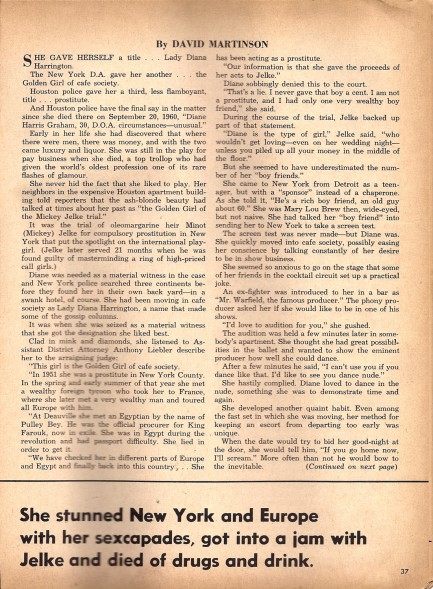 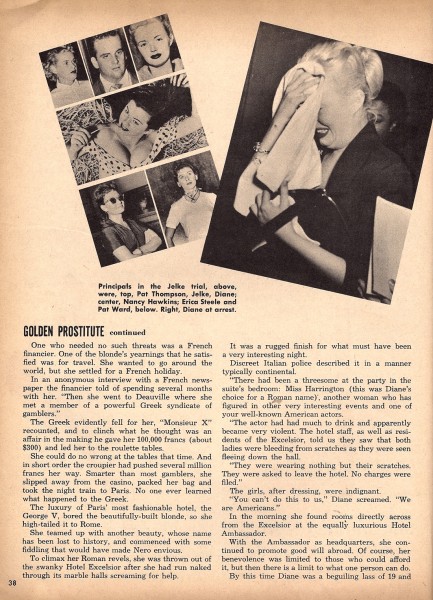 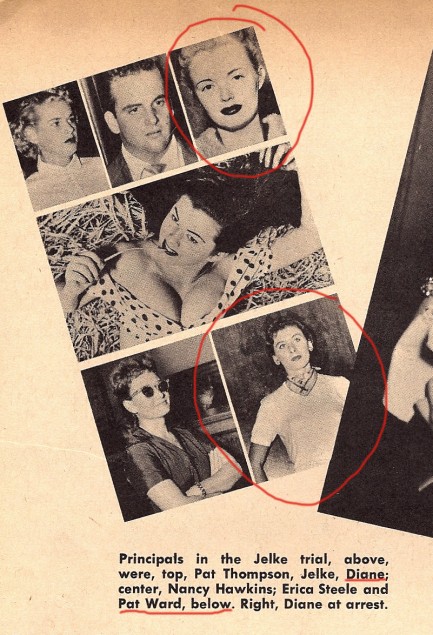 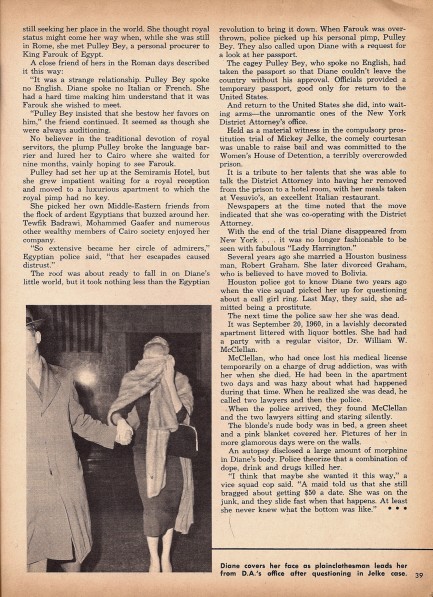 in more glamorous days were on the walls. An autopsy disclosed a large amount of morphine in her body. Police theorize that a combination of drink and drugs killed her. in more glamorous days were on the walls. An autopsy disclosed a large amount of morphine in her body. Police theorize that a combination of drink and drugs killed her. Diane Harris had wanted the best life had to offer, and money meant everything. All her friends and acquaintances knew that about her. According to her maid, even at the end she still bragged about once being able to command fifty dollars per date. An obsessive desire for luxury drove her into the arms of rich, uncaring men, and eventually, in order to maintain her high flying lifestyle, into prostitution. The one piece of her that endured long after she died naked and surrounded by bottles and pills was her famous nickname—The Golden Girl of Café Society. But she eventually lost that too.
 Police Gazette tries to draw correlation between meat and murder—of humans. 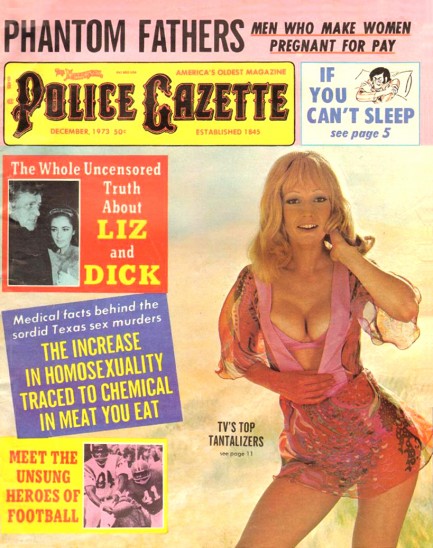
The good folks at the National Police Gazette are in rare form on this December 1973 cover. For instance, the teaser “The Truth About Liz and Dick” carries a rather interesting double meaning. Taylor was always bashed in the tabloid press for being a bit of a harlot, however, leaving aside the obvious sexism of the sentiment, her reputation was probably undeserved. Her fifth husband Richard Burton pointed out, during the height of the furor over their affair and marriage, that Taylor had loved only five men in her life and married them all, whereas certain actresses who had never been married might as well have had yield signs outside their bedrooms to deal with all the traffic. We’re paraphrasing. He was just trying to point out the chasm between perception and reality. Of course, the press didn’t care about that and dutifully continued to portray Taylor as a dragon lady. But that isn’t the story that interests us—we’ve talked about Taylor here and here, and that’s enough for this year. Check the text in the blue box. The editors pair a teaser about some murders in the Houston, Texas area with one suggesting chemicals in meat can turn you gay. You’re probably gay before you eat the meat, but that point notwithstanding, this is one of the most insidious pieces of gay-bashing you’re ever likely to find, because the murders to which Gazette editors are referring are none other than the Corll/Brooks/Henley killings of 1970-1973. They became known simply as the Houston Mass Murders, and they were the worst serial killings in American history at the time. We mean worst in terms of numbers—twenty-seven confirmed dead. And the sexual nature of the crimes had anti-gay forces ready to take to the streets. 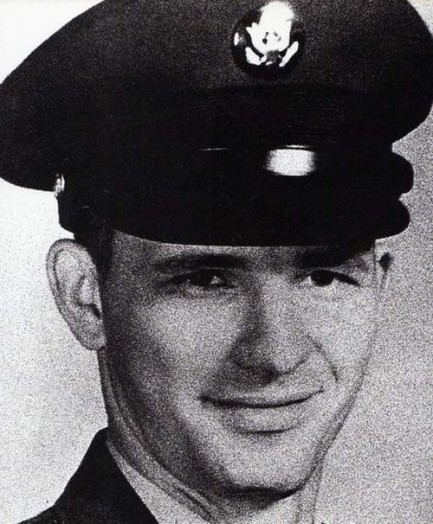 The story is stranger than anything we could invent—it involves a man, two boys, and an unholy pact between the three. When Elmer Wayne Henley met Dean Corll and David Brooks in 1970, Corll and Brooks had already killed nine Houston teenagers, including two boys Henley knew. Corll, pictured at left, was the leader, with the younger Brooks functioning as more of an assistant whose job was to lure attractive teenaged victims. Henley, who was fifteen at the time, was supposed to be just another victim, but Corll took a particular liking to him and recruited him. How he knew Henley would be amenable to the arrangement is one of those eternal mysteries. Henley could have simply appeased Corll long enough to get out of his clutches, then called the police. But in yet another validation of unerring serial killer instinct, Henley actually did join in the crimes. Like Brooks, his job was to lure fresh victims. For every boy he delivered, Corll paid two-hundred dollars. The story is stranger than anything we could invent—it involves a man, two boys, and an unholy pact between the three. When Elmer Wayne Henley met Dean Corll and David Brooks in 1970, Corll and Brooks had already killed nine Houston teenagers, including two boys Henley knew. Corll, pictured at left, was the leader, with the younger Brooks functioning as more of an assistant whose job was to lure attractive teenaged victims. Henley, who was fifteen at the time, was supposed to be just another victim, but Corll took a particular liking to him and recruited him. How he knew Henley would be amenable to the arrangement is one of those eternal mysteries. Henley could have simply appeased Corll long enough to get out of his clutches, then called the police. But in yet another validation of unerring serial killer instinct, Henley actually did join in the crimes. Like Brooks, his job was to lure fresh victims. For every boy he delivered, Corll paid two-hundred dollars. The arrangement worked fine until one night in mid-1973, when Henley brought his girlfriend and a male acquaintance to Corll’s house. We’re a little fuzzy on why that happened. It may have had something to do with the girlfriend deciding that night to run away from home, and Henley being somewhat baffled as to where to take her. At any rate, it’s clear he didn’t plan for Corll to harm her. However, Corll was enraged that Henley had brought two friends over. Keeping a low profile was crucial. After an argument, he seemed to calm down and began to drink and socialize. The teenagers got plastered and passed out—and awoke tied up. Corll screamed that he was going to torture and kill them all, but a desperate Henley convinced Corll he was still a loyal accomplice and would rape and kill his girlfriend while Corll dealt with the other boy. Corll agreed, but once untied, Henley got his hands on Corll’s pistol and shot him six times, leaving him in the very dead state you see below. By the time the December Police Gazette hit the streets, all of America was in an uproar over the murders. Corll had shot some boys, strangled others, and tortured them all in the most painful ways, including shoving glass rods up their urethras. All had been raped. And this meant Corll’s sexuality became central. So, taking all that into consideration, you can see that the Gazette is really being quite inflammatory on their cover. It would have been equally valid to discuss whether it is heterosexuality that leads to murder—after all, in terms of sheer numbers, straight folks have gay folks beat all to hell in the killing department. But as we’ve pointed out before, reason doesn’t sell tabloids, so the Police Gazette gleefully tarred an entire community in pursuit of profits. Now, as far as how they tie all this to chemicals in meat, well, that’s just too silly to get into today. Maybe some other time. Above: investigators unearth the skull of one of Corll's victims.
 A strange kind of love. 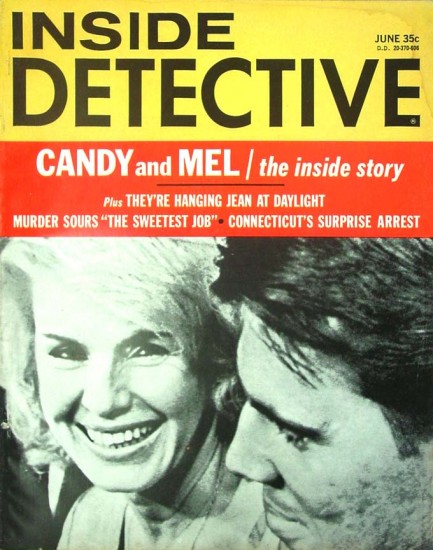
Here’s another piece of evidence that humanity isn’t becoming more depraved—we’ve always been that way. This Inside Detective from June 1966 tells the story of Candy and Mel. You’ve probably never heard of them, but there was a time when everybody in America knew their names. Candy Mossler was a Houston, Texas socialite married to a millionaire named Jacques Mossler. Unfortunately, the marriage wasn’t going well, so she turned to her live-in nephew Melvin Powers for a little lovin’. Though she was twice his age, she was also beautiful, so Melvin was happy to oblige his aunt, and the two of them embarked on a full-blown incestuous affair that was obvious to every servant in the family mansion but not to the oblivious Jacques. When Mossler did finally discover the truth he went to a lawyer for advice and was told the scandal would destroy his status, so he stewed and the affair went on under his roof. Jacques finally moved to his Key Biscayne vacation flat, but not long afterward turned up dead. Candy told police she suspected a burglar of the crime, but the police weren’t buying because Jacques had been stabbed thirty times then brained with a heavy glass bowl, acts not likely to be committed by a home invader. So Candy changed her story, and said she suspected Jacques was having an affair with a male lover who had knifed and glassed him. Police were willing to believe this, but as they collected more and more evidence the finger of suspicion began to shift inexorably toward Candy. Knowledge of her incestuous affair with Mel, along with a good look at what she stood to inherit now that Jacques was on a slab helped satisfy cops that they had their killers. Candy, of course, could afford the very best legal representation, though because of frozen bank accounts it meant hocking her diamonds and furs. But she was able to retain Percy Foreman, a well-known defense attorney of the day who later unsuccessfully defended James Earl Ray from charges that he assassinated Martin Luther King, Jr. In the end, it may have been Candy’s charm that carried the day more than Foreman’s defense. She made herself endlessly available to the press, always wearing a glamorous smile, and public opinion turned in her favor. She and Melvin Powers were both found not guilty of murder charges. No killer was ever found, nor even sought, because the police knew they had their perps and didn’t bother looking elsewhere, acquittal notwithstanding. It was the trial of the century in South Florida and Houston, at least until the next one came along. As for the love affair, Candy and Mel drifted apart over the years and she died in 1976 of an accidental overdose of migraine medication. But for a time she was a legitimate one-name celebrity—just Candy, the society dame who killed and got away with it.
|
 |

The headlines that mattered yesteryear.
1943—First LSD Trip Takes Place
Swiss scientist Albert Hofmann, while working at Sandoz Laboratories in Basel, accidentally absorbs lysergic acid diethylamide, better known as LSD, and thus discovers its psychedelic properties. He had first synthesized the substance five years earlier but hadn't been aware of its effects. He goes on to write scores of articles and books about his creation. 1912—The Titanic Sinks
Two and a half hours after striking an iceberg in the North Atlantic Ocean on its maiden voyage, the British passenger liner RMS Titanic sinks, dragging 1,517 people to their deaths. The number of dead amount to more than fifty percent of the passengers, due mainly to the fact the liner was not equipped with enough lifeboats. 1947—Robinson Breaks Color Line
African-American baseball player Jackie Robinson officially breaks Major League Baseball's color line when he debuts for the Brooklyn Dodgers. Several dark skinned men had played professional baseball around the beginning of the twentieth century, but Robinson was the first to overcome the official segregation policy called—ironically, in retrospect—the "gentleman's agreement". 1935—Dust Storm Strikes U.S.
Exacerbated by a long drought combined with poor soil conservation techniques that caused excessive soil erosion on farmlands, a huge dust storm known as Black Sunday rages across Texas, Oklahoma, and several other states, literally turning day to night and redistributing an estimated 300,000 tons of topsoil. |

|
|

It's easy. We have an uploader that makes it a snap. Use it to submit your art, text, header, and subhead. Your post can be funny, serious, or anything in between, as long as it's vintage pulp. You'll get a byline and experience the fleeting pride of free authorship. We'll edit your post for typos, but the rest is up to you. Click here to give us your best shot.

|
|

























 believes the Golden Girl is Diane Harris—not Patricia Ward. While it’s true that Harris did use some aliases, including Lady Diana Harrington and Mary Lou Brew, nowhere is the name Ward mentioned as a pseudonym.
believes the Golden Girl is Diane Harris—not Patricia Ward. While it’s true that Harris did use some aliases, including Lady Diana Harrington and Mary Lou Brew, nowhere is the name Ward mentioned as a pseudonym.
 point of a Hollywood motion picture misidentifying her. She was indeed Minot Jelke’s girlfriend, whereas Harris was just a fellow high dollar prostie (and corroborating witness), so perhaps some clever scribe, or even the writers of the 1995 movie, decided that such a catchy nickname would be better applied to the girlfriend. At least that’s the way it looks to us.
point of a Hollywood motion picture misidentifying her. She was indeed Minot Jelke’s girlfriend, whereas Harris was just a fellow high dollar prostie (and corroborating witness), so perhaps some clever scribe, or even the writers of the 1995 movie, decided that such a catchy nickname would be better applied to the girlfriend. At least that’s the way it looks to us.



 in more glamorous days were on the walls. An autopsy disclosed a large amount of morphine in her body. Police theorize that a combination of drink and drugs killed her.
in more glamorous days were on the walls. An autopsy disclosed a large amount of morphine in her body. Police theorize that a combination of drink and drugs killed her.

 The story is stranger than anything we could invent—it involves a man, two boys, and an unholy pact between the three. When Elmer Wayne Henley met Dean Corll and David Brooks in 1970, Corll and Brooks had already killed nine Houston teenagers, including two boys Henley knew. Corll, pictured at left, was the leader, with the younger Brooks functioning as more of an assistant whose job was to lure attractive teenaged victims. Henley, who was fifteen at the time, was supposed to be just another victim, but Corll took a particular liking to him and recruited him. How he knew Henley would be amenable to the arrangement is one of those eternal mysteries. Henley could have simply appeased Corll long enough to get out of his clutches, then called the police. But in yet another validation of unerring serial killer instinct, Henley actually did join in the crimes. Like Brooks, his job was to lure fresh victims. For every boy he delivered, Corll paid two-hundred dollars.
The story is stranger than anything we could invent—it involves a man, two boys, and an unholy pact between the three. When Elmer Wayne Henley met Dean Corll and David Brooks in 1970, Corll and Brooks had already killed nine Houston teenagers, including two boys Henley knew. Corll, pictured at left, was the leader, with the younger Brooks functioning as more of an assistant whose job was to lure attractive teenaged victims. Henley, who was fifteen at the time, was supposed to be just another victim, but Corll took a particular liking to him and recruited him. How he knew Henley would be amenable to the arrangement is one of those eternal mysteries. Henley could have simply appeased Corll long enough to get out of his clutches, then called the police. But in yet another validation of unerring serial killer instinct, Henley actually did join in the crimes. Like Brooks, his job was to lure fresh victims. For every boy he delivered, Corll paid two-hundred dollars.